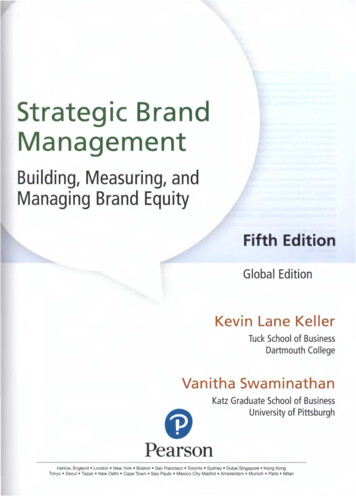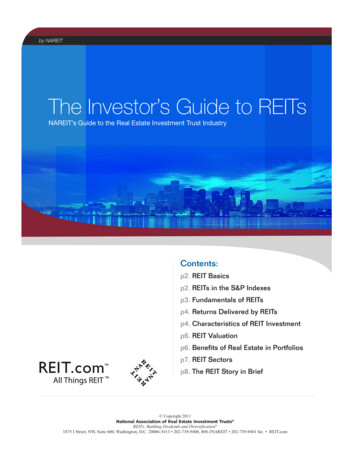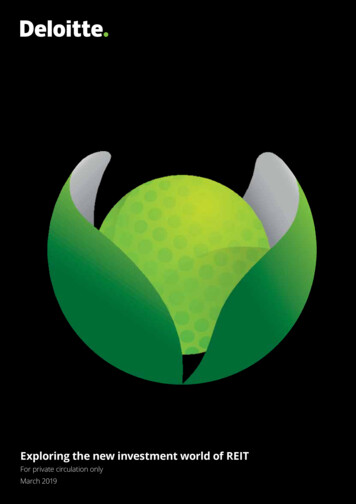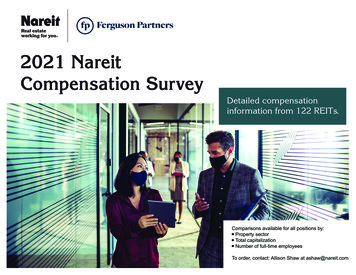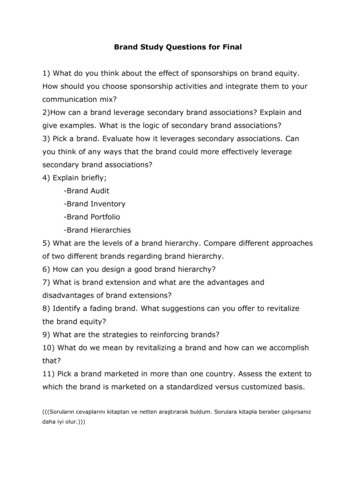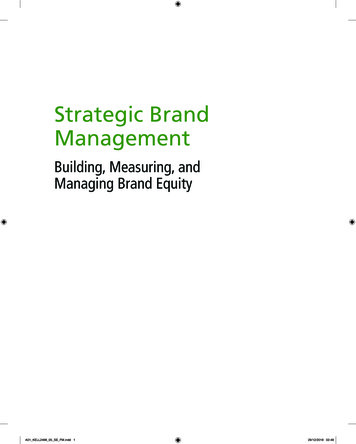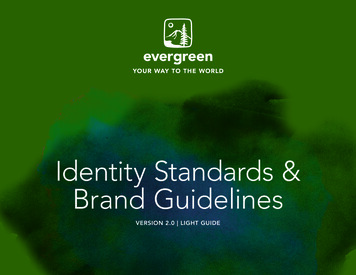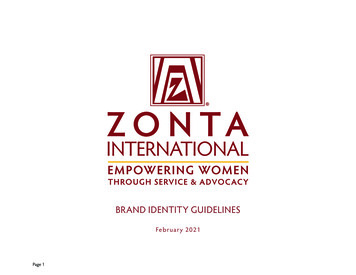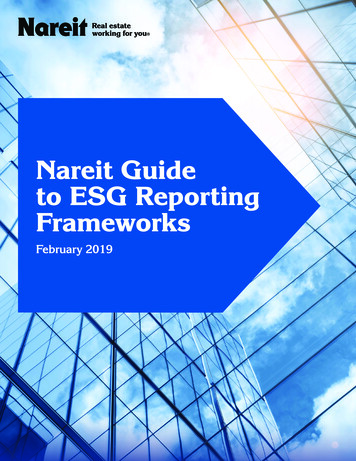
Transcription
Nareit BrandGuidelines:Nareit GuideMasterto ESG Reporting(Visual& Verbal Identity System)FrameworksApril2018February2019Visit nareitbrandcenter.com for more Nareit brand resources and templates. 2018 Nareit. All rights reserved.2017 Nareit. All rights reserved.
Message from the CEONareit is pleased to offer its members the Nareit Guide to ESG ReportingFrameworks. We produced this guide to help Nareit members betterunderstand and navigate the array of environmental, social and governance(ESG) reporting frameworks.This Guide is the product of a comprehensive review of the most relevantESG reporting frameworks in the marketplace today which may be used bya range of investors in public companies. It provides an overview of thoseframeworks and their most commonly used metrics in a single, user-friendlydocument.One reason we believe this Guide will be especially useful to Nareitmembers which are public companies is that all public companies arenow monitored and benchmarked relative to their peers (or likely to besoon) – irrespective of whether the company seeks it or not. Third-partydata aggregators, rating and ranking agencies and index providers are nowactive in the marketplace; and through their activities public companiesare measured and evaluated based solely or in part on whether publiccompanies make available in filings, reports and websites data and otherinformation anticipated by various ESG reporting frameworks.Given the growing prevalence of ESG reporting frameworks in theinvestment marketplace, it is clearly important for public companies,including REITs, to actively and effectively manage their ESG reporting.Nareit hopes the Nareit Guide to ESG Reporting Frameworks helps provideyou with the contextual knowledge, understanding and insight you may needto navigate through the various ESG reporting frameworks used by assortedinvestors in today’s marketplace.Steve WechslerPresident & CEONareitNareit Guide to ESG Reporting Frameworks20192
Table of Contents Over 73% of investorstake Environmental,Social and Governance(“ESG”) disclosureand performancemetrics into accountwhen evaluatingrisk and identifyingopportunities.—CFA InstituteOn public ESG disclosuretrends. November 2017WhatThis Guide to ESG Reporting4WhyDisclosure on Environmental, Social,and Governance Topics5HowMethodology6ESG Frameworks Explained7Summary of mmary of DistributionThird-Party Aggregator Frameworks13Environmental Third-Party14Social Third-Party15Governance Third-Party16ESG Controversies17Conclusion18Nareit Guide to ESG Reporting Frameworks20193
WhatThis Guide to ESG Reportingis intended to provide clarity and practicalinsights around the following:Barriers to Successful Useof ESG Standards, Ratings,and FrameworksnnToo many to navigate Lack of capacity to analyze requirementsnOverly complex processesnData accuracy is questionablenTime and resource constraintsnConcerns about “going public” with datannnESG Frameworks most relevant to Nareit membersWith more than a dozen ESG reporting, disclosure, andranking platforms used by investors, understandingthe universe of ESG frameworks is critical to effectivelymeeting stakeholder expectations. The Guide to ESGReporting Frameworks provides practical informationfor REITs about what frameworks exist, how they areused, and what the key differences are between them.Lack of clarity around how to measureand discloseInconsistent disclosure requestsNo direction or understanding ofwhere to startPrioritization and explanation of the mostfrequently referenced ESG disclosure areas andmetrics used by investorsCommonalities in ESG disclosure areas and metricscan be found across all ESG frameworks. The Guideto ESG Reporting Frameworks identifies, prioritizes,and explains the key disclosure themes and theirassociated metrics to enable Nareit members tostreamline and improve disclosure practices.Risks and opportunities associated with ESGdisclosure practicesWith greater focus on ESG performance, disclosurestrategies are increasingly consequential. TheGuide to ESG Reporting Frameworks highlights theopportunities associated with an organization’sdisclosure practices.Nareit Guide to ESG Reporting Frameworks20194
WhyDisclosure on Environmental,Social, and Governance (ESG)TopicsThe REIT and publicly traded real estate industry continues to experiencegrowing demand from stakeholders to effectively disclose and manage ESGperformance.However, the proliferation and diversification of these frameworks makeit increasingly challenging and resource-intensive for managers andpractitioners to meet ESG disclosure expectations. This document intends toprovide clarity and guidance to Nareit’s members as they navigate the ESGdisclosure landscape, which continues to become increasingly prominent andincreasingly complex.Nareit has conducted a comprehensive reviewof the most relevant and commonly used ESGframeworks to identify the ESG metrics mostfrequently considered for evaluation.“There is a fundamental need to consolidate reportingobjectives for Nareit members. With more streamlinedreporting expectations, companies could moreefficiently allocate resources to developing andimplementing sustainable ESG strategies.”—Chris LazSenior Director, Corporate Marketing and CommunicationsRealty Income CorporationNareit Guide to ESG Reporting Frameworks20195
HowMethodologyNareit conducted a comprehensive analysis with the support of AccountAbility,an independent, global sustainability consulting, and standards firm. The processincluded three phases: Identify, Analyze, and Prioritize.1IdentifyNareit and AccountAbility conducteda review of 12 unique ESG reportingframeworks, covering a range of industryfocus areas and disclosure requirements.The frameworks were then evaluatedusing criteria and filters deemed to bemost relevant to Nareit’s members,including: industry recognition andrelevance; utilization among investors andother key stakeholders; and availability,quality, and granularity of disclosurerequirements. The top 10 most relevantand useful ESG reporting frameworkswere selected for inclusion.Frameworks Reviewed:Bloomberg Terminal ESG AnalysisCDPDow Jones Sustainability Indices (DJSI)Global Real Estate SustainabilityBenchmark (GRESB)Global Reporting Initiative (GRI)Institutional Shareholder Services (ISS E&S)Quality ScoreIntegrated Reporting (IR)*MSCISustainability Accounting Standards Board(SASB)SustainalyticsTask Force on Climate-related FinancialDisclosures (TCFD)UN Sustainable Development Goals(UN SDGs)**IR and UN SDGs were not selected for inclusion in analysis asthey do not delineate specific metrics and KPIs for disclosure.23The 10 ESG reporting frameworks werefirst sorted according to whether theywere voluntary disclosure frameworks,guidance frameworks, or third-partyaggregated frameworks.KPIs were prioritized by the number ofESG reporting frameworks, out of the10 reviewed, that mention each KPI atleast once.AnalyzePrioritizeVoluntary disclosure frameworks areframeworks through which a companymight actively disclose its sustainabilityrelated policies, practices, andperformance data and information. Thesemay take the form of questionnaires usedfor evaluation and ranking.Guidance frameworks are those thatprovide recommended methodologiesand guidance as to how organizationsmight identify, manage, and report onsustainability performance.Third-party aggregator frameworksare frameworks which assessperformance based on aggregated,publicly available data, includingcompany-sourced filings andpublications, such as company websites,annual reports, and/or sustainability orCSR reports.There were found to be three voluntarydisclosure frameworks, threeguidance frameworks, and four thirdparty aggregation frameworks.Derived from the 10 ESG reportingframeworks are 41 key performanceIndicators (KPIs), which consist of 735ESG questions/metrics, divided betweenfour categories: Environmental, Social,Governance, and ESG Controversies.The frequency of the 735 ESG questions/metrics was also calculated within eachKPI across the 10 ESG frameworksto better understand their granularity,distribution and definitions.The five most frequent KPIs withineach category were identified andpractical definitions and tips weredistilled for each, as described in thisguide.The GRI Standards are comprehensivedisclosure guidelines for sustainabilityreporting. The GRI Standards require thatcompanies conduct a formal assessmentto determine the KPIs and metrics thatare most relevant to the organization andits stakeholders. The Nareit Guide to ESGReporting Frameowrks includes only the KPIsand metrics from the GRI Standards thatare most relevant to the real estate industry.Users of the GRI Standards will need toreview all disclosures that might be materialto their business.Nareit Guide to ESG Reporting Frameworks20196
ESG Frameworks ExplainedThe following three ESG Framework categories—voluntary disclosure frameworks, guidance frameworks, and third-party aggregators—were reviewed and distilled to determine the most frequently used key performance indicators (KPIs). Below is a description of eachESG Framework, including disclosure protocol and active users.Voluntary Disclosure FrameworksFrameworkDescriptionInformation SourceCDPGlobal disclosure program that enables participants to measure andmanage their environmental impacts and link environmental integrity,fiduciary duty and public interest so companies, investors, and other globalstakeholders can benchmark performance and make better-informeddecisions on climate actions.Voluntary disclosure of non-financial data,including greenhouse gas emissions and companyenvironmental performance, focused on climatechange, forests, and water security. Performanceis benchmarked against industry peers, scoredand ranked publicly. Company results are publiclyavailable.Global Real EstateSustainabilityBenchmark (GRESB)Validates, scores, and benchmarks ESG performance data. Particular focuson real estate funds and property companies.Voluntary disclosure of building-relatedESG data, assets, and real estate portfolios.Company results are publicly available.Dow JonesSustainability Indices(DJSI)An index of top-performing companies in terms of economic, environmental, Voluntary disclosure through a subscriptionand social criteria, which serves as benchmarks for investors. Only topbased survey of building-related ESG data, assets,ranked companies within each industry are selected for inclusion in the DJSI. and real estate portfolios. Company results arepublicly available.Guidance FrameworksFrameworkDescriptionInformation SourceSustainabilityAccounting StandardsBoard (SASB)Sustainability accounting standards focused on known trends anduncertainties that are reasonably likely to affect the financial condition oroperating performance of a company and would therefore be consideredmaterial* under Regulation S-K.Voluntary disclosure of relevant sustainabilitymetrics in company financial disclosures,segmented by industry.Global ReportingInitiative (GRI)Highly specific disclosure guidelines and requirements for compliantnon-financial sustainability reporting on economic, environmental andsocial performance areas. The standards are modular and can be used in aselective fashion to meet the desired compliance level and disclosure needsof the reporting organization.Voluntary disclosure through a formal digitalor printed sustainability report, including allESG topics deemed to be relevant to theorganization and all related management approachcomponents.Task Force onClimate-relatedFinancial Disclosures(TCFD)Comparable and consistent disclosures used to demonstrate corporateclimate change risk assessment, scenario planning and resilience. Unlikeother environmental reporting initiatives, TCFD requires organizations toreport on their response to environmental pressures, rather than their impacton the environment.Voluntary disclosure within mainstream annualfinancial filings of the identification, assessment,management, and oversight policies andpractices affiliated with climate-related risks andopportunities in the areas of governance, strategy,risk management, and metrics and targets.*SASB guidance states that its definition of the term materiality is ‘informed” by “the provisions of the federal securities laws and the regulations of the Securities and Exchange Commission,” and “opinions of the U.S.Supreme Court.” See, SASB, Approach to Materiality and Standards Development available at https://library.sasb.org/materiality bulletin/ Accordingly, SASB’s determination that a fact is material to investors may differfrom a materiality finding made by the SEC, another regulatory body, or a relevant court under applicable Supreme Court precedent. See, TSC Industries v. Northway, Inc., 426 U.S. 438, 449 (1976). See also Basic, Inc.v. Levinson, 485 U.S. 224 (1988). As the Supreme Court has noted, determinations of materiality require “delicate assessments of the inferences a ‘reasonable shareholder’ would draw from a given set of facts and thesignificance of those inferences to him . . . .” TSC Industries, 426 U.S. at 450.Nareit Guide to ESG Reporting Frameworks20197
ESG Frameworks ExplainedcontinuedThird-Party AggregatorsFrameworkDescriptionInformation SourceAggregated summary of a company’s ESG performance and risk, bothhistorically and relative to peers. The ranking and ratings measuretransparency and are gathered from Bloomberg’s proprietary research aswell as third-party ESG data disclosure agencies.Third-Party Aggregation: Data is aggregatedand assessed based on public company-sourcedfilings, such as annual reports and sustainability orCSR reports, and company websites. Data is alsoobtained from a proprietary Bloomberg survey.Private service, must subscribe to access data.InstitutionalShareholder Services(ISS E &S) Quality ScoreMeasures the depth, extent, and quality of public corporate disclosures onenvironmental and social issues, including governance, and identifies keydisclosure omissions.Third-Party Aggregation: Data is aggregatedand assessed based on mainstream filings,Sustainability and CSR reports, integratedreports, publicly available company policies andinformation. Company results are publicly available.MSCIComprehensive fixed income risk and performance analytics based ontrends across sectors and regions that help investors identify risks andopportunities, pinpoint outliers, and focus on key ESG performance drivers.Third-Party Aggregation: Data is aggregatedand assessed based on 100 specialized datasetsfrom governments, NGOs and models; companydisclosure via 10-K, sustainability reports, andproxy reports; and over 1,600 media sourcesmonitored daily. Private service, must subscribe toaccess data.SustainalyticsESG and corporate governance research and rankings that measureThird-Party Aggregation: Data is aggregatedexposure to and management of material ESG risks, specifically considering and assessed based on public company-sourcedthree dimensions: preparedness; disclosure; and performance.filings and media reports. Private service, mustsubscribe to access data.Bloomberg TerminalESG AnalysisNareit Guide to ESG Reporting Frameworks20198
Summary of DistributionThe ESG Key Performance Indicators (KPIs) that appear most frequently among the 10 ESGReporting Frameworks are as follows:ENVIRONMENTAL KPIsESG Framework FrequencyClimate change opportunities and riskEnvironmental Management Systems10 / 109 / 108 / 108 / 107 / 10SOCIAL KPIsESG Framework FrequencySupply Chain - SocialDiversity and Equal Opportunity8 / 107 / 107 / 107 / 106 / 10GOVERNANCE KPIsESG Framework FrequencyEmissions - Green House Gas EmissionsEnvironmental PolicyEnergyStakeholder EngagementHealth and SafetyWorkforce Development/Human CapitalCompensation PolicyESG Reporting StandardsBoard Level Oversight - ESGGovernance PolicyGovernance Risk Assessment7 / 106 / 106 / 106 / 106 / 10Nareit Guide to ESG Reporting Frameworks20199
EnvironmentalEnvironmental KPIs reflect an organization’s processes, policies, practices and impact with regard to the naturalenvironment. Of the 10 ESG reporting frameworks that Nareit studied, the top five most frequent environmentalKPIs are as follows:Environmental KPIs10Out of 10frameworksESG FrameworkFrequency9Out of 10frameworksESG FrameworkFrequency8Out of 10frameworksESG FrameworkFrequencyREITs disclosing environmentalperformance metrics andstrategies see approximately5% increase in property-leveland corporate-level cash flowsavailable for distribution toshareholders.Climate ChangeOpportunities and RiskA company’s strategy, planning, and policies forclimate-related business risks and opportunities.Disclosures explain the tools and methodologiescompanies use to identify, assess, and addressclimate change, and how these approaches areintegrated into overall risk management andbusiness strategy.Greenhouse Gas (GHG)EmissionsIncludes all greenhouse gas (GHG) emissions-relatedmetrics and policies for a company across Scope1 (direct, onsite), Scope 2 (purchased energy), andScope 3 (extended indirect). Disclosures requireverifiable information and standardized data for theemissions resulting from company operations andproducts, as well as descriptions of programs andpolicies seeking to reduce or otherwise mitigatenegative emissions.EnergyCovers all energy-consumption related metrics andpolicies for a company. Disclosures include specificdata and metrics on energy use and energy spend bysource, with specific emphasis on renewable energyuse. Disclosures cover programs and metrics relatedto energy reduction, efficiency and conservation forall company operations and products.— Social Science Research NetworkWhy reporting does matter. January 2013.8Out of 10frameworksESG FrameworkFrequency7Out of 10frameworksESG FrameworkFrequencyEnvironmental PolicyThe presence and completeness of an organization’senvironmental management policies, what theycontain, and how they are managed. Disclosuresdescribe company policies related to environmentalprotection, responsible building development,carbon pricing, supply chain, resilience scenarioplanning, compliance with regulation, andmanagement/approval from senior leadership,among others.Environmental ManagementSystemsDetails the systematic management of anorganization’s environmental programs, and whetheror not an organization has a documented structure inplace. Disclosures focus on policies and proceduresin place to govern operations, tools and platformsto collect, monitor and manage environmental data,and processes to evaluate and mitigate negativeimpact. Emphasis is placed on target-setting andcontinuous monitoring.Nareit Guide to ESG Reporting Frameworks201910
SocialSocial KPIs reflect an organization’s processes, policies, practices and impact with regard to the people—both internaland external—with whom it interacts. Of the 10 ESG Reporting Frameworks that Nareit studied, the top five mostfrequent social KPIs are as follows:Social KPIs8Out of 10frameworksESG FrameworkFrequency7Out of 10frameworksESG FrameworkFrequency7Out of 10frameworksESG FrameworkFrequencySupply Chain – SocialIncludes the management and performance of socialaspects of a company’s supply chain, includingworkforce and labor standards, codes of conduct,transparency, health and safety, and ESG integration.Disclosures cover whether or not organizationshave screening policies and procedures in placeto ensure their suppliers and vendors have strongsocial practices.7Out of 10frameworksESG FrameworkFrequencyDescribes policies and practices related to outreachand communication efforts with a company’s internaland external stakeholders. Engagement includesformal and informal communications, customerfeedback, employee surveys, and communityoutreach, among others. Disclosure also focuseson stakeholder engagement related to ESG issues,such as sustainability reporting and disclosure, ESGcontroversy publications, and others.Disclosures focus on company’s policies andpractices related to employee workforce training,as well as talent attraction and retention. Specificmetrics include the number of hours of training peremployee, employee turnover rate, and percent ofemployees receiving regular performance reviews,among others. Disclosures also cover specificpolicies related to human rights and CSR trainings.Policies and practices related to occupational healthof employees. Disclosures cover verifiable data andstandardized metrics related to employee injuries,absentee rate, fatalities, lost-time injury frequency,and lost days, among others. Disclosures alsoexplain specific policies related to employee health,nutrition, and overall access, as well as supplier/vendor/contractor health and wellbeing policies.GRESB defines stakeholderengagement as essential to a realestate portfolio. For real estateorganizations, typical stakeholdersinclude investors, employees,tenants, property management,supply chain vendors and thesurrounding community.Stakeholder EngagementWorkforce Development/Human CapitalHealth and Safety— Stakeholder engagement - the Why,Who, What, & How? November 20176Out of 10frameworksESG FrameworkFrequencyDiversity and EqualOpportunityDescribes strategies and policies in placesurrounding gender, diversity, and other workforcedemography practices. Includes metrics onworkforce demographics as well as diversitystrategy throughout the organization. Specificfocus on providing policies around workplacediscrimination, gender, racial, and ethnic equality,diversity programs, and other workforce hiring anddevelopment practices.Nareit Guide to ESG Reporting Frameworks201911
GovernanceGovernance KPIs reflect an organization’s processes, policies, practices and impact with regard to its formalizedgoverning infrastructure, transparency, roles and responsibilities and accountability. Of the 10 ESG ReportingFrameworks that Nareit studied, the top five most frequent governance KPIs are as follows:Governance KPIs7Out of 10frameworksESG FrameworkFrequency6Out of 10frameworksESG FrameworkFrequency6Out of 10frameworksESG FrameworkFrequencyAccording to GRESB, strong ESGpractices coupled with publicdisclosure results in superiorinvestment returns in the form ofhigher rental income and lowerinterest expenses, which leads toincreased cash distribution and alower risk profile.Compensation PolicyDescribes a company’s strategy and practicesfor compensation across the company—from lineworkers to C-suite and board members. Disclosuresdiscuss incentive programs and targets generally,as well as incentives specifically related to ESGperformance. Compensation data is disclosed,as well as descriptions of policies, strategies, andprocesses for remuneration.Governance PolicyIncludes disclosures related to the system of rules,practices, and processes that direct and control theorganization. Disclosures cover risk management,corporate structure, management approach, datapolicies, and adherence to regulation, among others.Specific focus on describing the policies in place andthe strong accountability and oversight behind eachpolicy.Board Level Oversight—ESGOutlines the roles and responsibilities of thecompany’s board of directors specific to goalsetting, strategy, and remuneration, among others.Disclosures include descriptions of the board’sresponsibility and oversight of the company’s ESGperformance.— Transparency and the business case forESG in Real Estate. March 20186Out of 10frameworksESG FrameworkFrequency6Out of 10frameworksESG FrameworkFrequencyESG Reporting StandardsIndicates whether or not an organization is publiclydisclosing ESG information using frameworks (e.g.SASB, ISO, etc.), or if it is a member of internationalESG-related compacts or agreements (UNGC, CDP,UN SDGs, etc.).Governance Risk AssessmentDescribes company strategy and processes relatedto issues of security, data, and financial risk, as wellas overall company risk culture. Specific disclosurefocuses on risk governance procedures and policiesand how they are integrated into overallrisk strategies.Nareit Guide to ESG Reporting Frameworks201912
Summary of Distribution:Third-Party Aggregator FrameworksWhen Nareit looked at only the four third-party aggregator frameworks reviewed (MSCI, BloombergTerminal, Sustainalytics, and ISS E&S), the most common KPIs in these frameworks were mostly identicalto the 10 frameworks that were initially reviewed. The differing ESG KPIs were: Environmental Products andServices; Responsible Business Practices, Codes and Programs; and Board Structure.The ESG Key Performance Indicators (KPIs) that appear most frequently among th four third-partyaggregator frameworks are as follows:ENVIRONMENTAL KPIsESG Framework FrequencyClimate Change Opportunities and RiskEnvironmental Policy4/44/44/43/43/4SOCIAL KPIsESG Framework FrequencySupply Chain - SocialDiversity and Equal Opportunity4/44/44/43/43/4GOVERNANCE KPIsESG Framework FrequencyEmissions - Green House Gas EmissionsProducts and ServicesEnergyWorkforce Development/Human CapitalHealth and SafetyStakeholder EngagementCompensation PolicyResponsible Business Practices, Codes and ProgramsESG Reporting StandardsGovernance PolicyBoard Structure4/44/43/43/43/4Nareit Guide to ESG Reporting Frameworks201913
Environmental Third–PartyThird-Party aggregator frameworks are frameworks which assess performance based on aggregated, publicly available data,including company-sourced filings and publications, such as company websites, annual reports and/or sustainability or CSR reports.Regardless of whether or not your company is voluntarily disclosing this information, your company is likely being reviewed by thethird-party aggregation frameworks in these five environmental KPIs, among others.Environmental KPIs4Out of 4frameworksESG FrameworkFrequency4Out of 4frameworksESG FrameworkFrequency3Out of 4frameworksESG FrameworkFrequencyProducts and ServicesStrategies and programs designed tomanufacture and distribute low-carbon,sustainably packaged, climate change-oriented,and/or sustainability related products or services.Also includes risk management approachesassociated with products that contain harmfulchemicals and products, activities and servicesthat have significant impacts on the environment.Greenhouse Gas(GHG) EmissionsIncludes all greenhouse gas (GHG) emissionsrelated metrics and policies for a company acrossScope 1 (direct, onsite), Scope 2 (purchasedenergy) and Scope 3 (extended indirect).Disclosures require verifiable information andstandardized data for the emissions resulting fromcompany operations and products, as well asdescriptions of programs and policies seeking toreduce or otherwise mitigate negative emissions.4Out of 4frameworksESG FrameworkFrequency3Out of 4frameworksESG FrameworkFrequencyClimate ChangeOpportunities and RiskA company’s strategy, planning, and policies forclimate-related business risks and opportunities.Disclosures explain the tools and methodologiescompanies use to identify, assess, and addressclimate change, and how these approaches areintegrated into overall risk management andbusiness strategy.Environmental PolicyThe presence and completeness of anorganization’s environmental managementpolicies, what they contain, and how they aremanaged. Disclosures describe company policiesrelated to environmental protection, responsiblebuilding development, carbon pricing, supplychain, resilience scenario planning, compliancewith regulation, and management/approval fromsenior leadership, among others.EnergyCovers all energy-consumption related metricsand policies for a company. Disclosures includespecific data and metrics on energy use andenergy spend by source, with specific emphasison renewable energy use. Disclosures coverprograms and metrics related to energyreduction, efficiency and conservation for allcompany operations and products.Nareit Guide to ESG Reporting Frameworks201914
Social Third–PartyThird-Party Aggregator Frameworks are frameworks which assess performance based on aggregated, publicly available data,including company-sourced filings and publications, such as company websites, annual reports and/or sustainability or CSR reports.Regardless of whether or not your company is voluntarily disclosing this information, your company is likely being reviewed by thethird-party aggregation frameworks in these five social KPIs, among others.Social KPIs4Out of 4frameworksESG FrameworkFrequency4Out of 4frameworksESG FrameworkFrequency3Out of 4frameworksESG FrameworkFrequencyHealth and SafetyPolicies and practices related to occupationalhealth of employees. Disclosures cover verifiabledata and standardized metrics related toemployee injuries, absentee rate, fatalities,lost-time injury frequency, and lost days, amongothers. Disclosures also explain specific policiesrelated to employee health, nutrition, and overallaccess, as well as supplier/vendor/contractorhealth and wellbeing policies.Workforce Development/Human CapitalDisclosures focus on company’s policiesand practices related to employee workforcetraining, as well as talent attraction and retention.Specific metrics include the number of hours oftraining per employee, employee turnover rate,and percent of employees receiving regularperformance reviews, among others. Disclosuresalso cover specific policies related to humanrights and CSR trainings.4Out of 4frameworksESG FrameworkFrequency3Out of 4frameworksESG FrameworkFrequencySupply Chain—SocialIncludes the management and performanceof social aspects of a company’s supply chain,including workforce and labor standards, codesof conduct, transparency, health and safety, andESG integration. Disclosures cover whether ornot organizations have screening policies andprocedures in place to ensure their suppliers andvendors have strong social practices.Stakeholder EngagementDescribes policies and practices related tooutreach and communication efforts with acompany’s
Nareit Guide to ESG Reporting Frameworks 2019 8 Framework Description Information Source Aggregated summary of a company's ESG performance and risk, both historically and relative to peers. The ranking and ratings measure transparency and are gathered from Bloomberg's proprietary research as well as third-party ESG data disclosure agencies.
